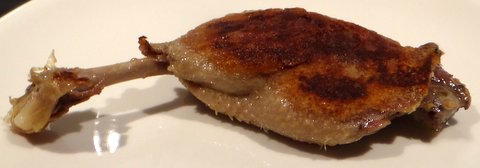
Unlike duck breast, duck legs are tough and need low & slow cooking to make them tender. Confit is a traditional French preparation to cook the legs low and slow in duck fat to make them tender as well as preserve them. To make duck leg confit the traditional way, you need quite a bit of duck fat. With sous-vide techniques you can get the same result with only one tablespoon of duck fat for each leg. Unlike other sous-vide preparations, there are no advantages in texture, which is the same as traditional. It is possible to make duck legs tender with sous-vide at lower temperatures (i.e. 62C/144F) with a different texture, but sous-vide confit is cooked at 82C/180F to obtain a traditional confit texture. Apart from using much less duck fat, the advantage is also that temperature control is very easy. Just set your water bath to 82C/180F and it will do the rest for you. Since this was my first experiment with sous-vide duck leg confit, I followed the instructions from Modernist Cuisine.
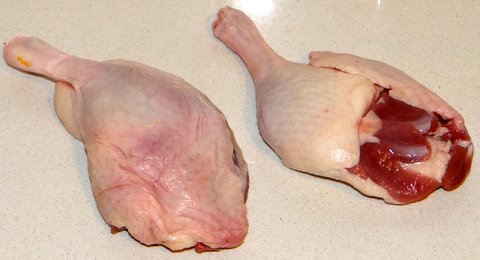
I started with a pair of duck legs. French/European ducks apparently are smaller than their American counterparts at 250 grams (about 1/2 pound) per leg, rather than the 400 grams (.9 lbs) Moulard duck legs described in Modernist Cuisine.

I used a very simple cure mix, consisting of salt, dried sage, and freshly ground black pepper.
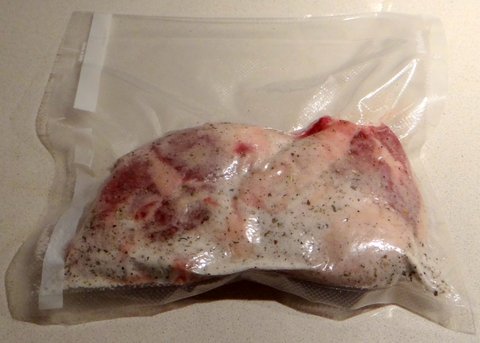
I packed the cure as evenly as I could on the duck legs, and vacuum sealed them to facilitate the curing process. I followed the Modernist Cuisine recommendation of using 18% by weight cure mix (i.e. 90 grams of cure for 500 grams of duck legs) and a curing time of 10 hours.

This is what the cured legs looked like after 10 hours. The salt had drawn out some of the juices, and had also penetrated the meat.
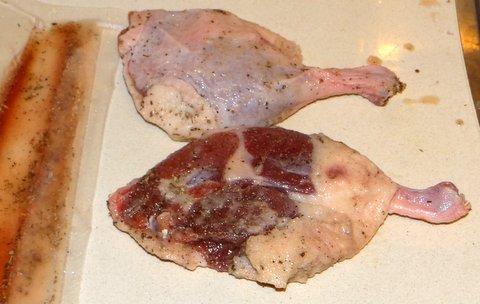
I had not adjusted the curing time for the smaller leg size, which I should have because the legs ended up being a bit on the salty side. With the same size of the duck legs, next time I will probably opt for only 6 hours or so of curing.
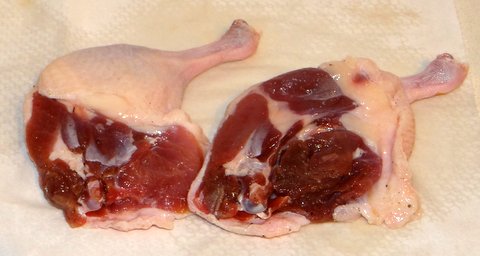
I rinsed the duck legs with cold water to remove all of the salt, and patted them dry with paper towels.

Then I sealed them into a vacuum pouch again, with a tablespoon of duck fat for each of the legs. (This duck fat was rendered from the duck breasts used for my recent duck breast experiment.)
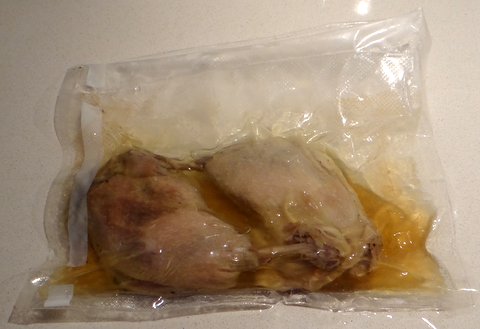
The legs were cooked sous-vide at 82C/180F for 8 hours.
You can now let them cool slightly and progress to the next step, or cool them quickly in ice water and refrigerate them until you are ready to serve and then reheat 12 minutes at 80C/176F.

I browned the legs quickly in a very hot frying pan.

The result was very tender flaky duck meat with crispy skin.

The taste was great but a bit too salty, so next time I will use a shorter cure time for the same size duck legs. The cooking time and temperature were perfect as the meat was tender and succulent.
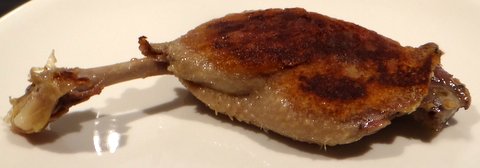

Do you see any reason you shouldn’t use pork fat? Just easier to obtain.
LikeLike
This small amount of duck fat is easy to obtain from cooking duck breasts, and like CampariGirl said it has a better flavor.
LikeLike
mmmm Bob, duck fat is so much more delicious, with a hint of sweetness to it. Stefan, next I would love to see French fries fried in duck fat….(and then we will all go on a cleanse)
LikeLike
I’m sure that would be lovely, but I don’t think I could get that much duck fat. Goose fat however is available in huge cans, so that could work…
LikeLike
I’ve been reading about sous-vide cookery for a while now. It seems a little daunting. Maintaining such precise temperatures sounds hard without specialized equipment…
LikeLike
I wouldn’t even attempt it w/o an immersion cooker. Good news is Sous Vide Supreme is under $200. These are absurdly easy to use. You basically just fill with water, set the temp and drop your vacuum packs in. Well worth it. Texture and flavor to fish, chicken, meat, that you have never experienced (maybe at a restaurant with an immersion circulator).
LikeLike
And seperate vacuum packing equipment, or do you just need bags?
LikeLike
SVS for under $200 sounds VERY cheap. I paid more than triple that for mine…
LikeLike
With the specialized equipment it’s not daunting at all. If it’s true that SVS is available for $200, I’d go for it if I were you…
LikeLike
Actually, $260 is cheapest I see it for right now. I looked it up and that is what I paid. I misspoke before.
LikeLike
That is still an amazing price.
LikeLike
You will probably want it at some point, but you can start with ziploc bags. I recommend the heavy duty freezer kind. In fact, one of the weaknesses of the vacuum bags is that you can’t use wet ingredients. Your only choice is ziploc (submerge them in water as you close, in order to get all air out). Or freeze you liquid ingredients before vacuum sealing. I do a little of both.
LikeLike
The ziploc bags are great. Instead of using those or frozen liquids, you can of course also buy a chamber vacuum sealer, but those are big and expensive.
LikeLike
Did you ever do crispy peking duck (or similar)? I’ve been reading your posts for ages but i cant remember seeing that one – ever consider giving it a try? especially interested to see whether you;d give making hoisin sauce from scratch a go
LikeLike
In fact I did some experimenting with that last week, but it was a bit of a last-minute thing with a friend that was not properly documented for blogging nor properly researched. It was OK, but I want to do it better before posting about it. Blowing up the duck with a bike pump to loosen the skin was fun, though…
LikeLike
LOL yes i read about that – and hanging it up in a cool airy place and so on. Funnily enough my amateur attempt has had more ‘views’ than anything else – 900 people have looked for and found an amateur attempt at crispy peking duck!
LikeLike
I’ll have to check that out! We didn’t have time to let it dry properly (only for 4 hours or so), so it didn’t turn out as crispy as needed. The homemade pancakes were quite good though 🙂
LikeLike
Did you rinse off the cure after opening the bag?
LikeLike
Yes, as described in the blog. Or do you mean something else?
LikeLike
Sorry I missed that part. I’ve had bad experiences with curing and brining as well. I learnt that you have to wash it quite thoroughly, first rinse it off, then soak, refresh, soak, refresh
LikeLike
Ah, now I see what you meant. Thanks for the comment. I only rinsed once, very thoroughly, and did not soak (let alone twice). I think a shorter brining time will give a similar result with less work compared to the soaking you describe, or am I missing something?
LikeLike
The process is called purging and is used in curing of larger cuts like hams. Try a 2-3 hour purge in cool water and let them rest overnight before proceeding so the brine equalizes
LikeLike
Masterful as ever Stefan. I admire your open admissions regarding the seasoning. I would have bluffed it and pretended everything came out perfect.
LikeLike
Thanks, Conor. It’s great to learn from other people’s mistakes…
LikeLike
Very cool. We never made confit because of the effort involved…but this is much more manageable….
LikeLike
It certainly is! I have done confit before using a big jar of goose fat, but didn’t brine first. It came out great, but it was too much goose fat to keep.
LikeLike
This is another great, informative post, Stefan. I doubt that I’ll be buying any of the equipment anytime soon — I’ve declared a moratorium on small appliance purchases — but, if I do, I know where to come for information on using it. Thanks. Salty or not, those duck legs look moist and delicious.
LikeLike
A water bath is not really ‘small’, so perhaps that could be a loophole in your moratorium 😉
They were quite good actually, the salt just overpowered the duck taste a bit.
LikeLike
Nice post, Stefan, and the timing could not be more perfect. I have a whole duck in the freezer and was considering, among other things, doing sous vide confit with the legs. Sous vide seemed the perfect technique for this dish. Now, I must give it a try. 🙂
LikeLike
Thanks, Richard. Would love to read about your sous-vide duck leg confit experiences…
LikeLike
How interesting! There’s just something about making duck confit the traditional way, fat and all… I’ll have to think about this one!
LikeLike
The Modernist Cuisine folks actually did blind tests and even very traditional chefs liked the duck confit that was cooked sous-vide with only a few tablespoons of fat.
LikeLike
I have confit many duck legs. I used to make it for my restaurant and also provided confit duck legs to other establishments. I do it the old fashion way. For the dry brine for 1kg of rock salt or sea salt I use 30 gr of salpeter or sodium nitrate, 50 gr sugar, 1 pulverized bay leave , 1 tsp of pepper and a dash of cloves. It takes me at least 12 hours, in many water bath, to remove the salt. The boiling is done in duck fat. The sous vide is very interesting but I wonder if the method provides the same quality in taste, colour and texture.
LikeLike
I haven’t done any side by side testing of sous-vide versus traditional, but I know that the Modernist Cuisine guys have (I assume you have heard of them?) and they claim that in a blind tasting nobody could tell the difference. The main advantage is that you don’t need as much duck fat.
LikeLike
Great how-to – always looking for new ways to sous vide my duck. I cook mine for 10 hours at 155, then broil skin side up: http://goo.gl/XidJIe
LikeLike
Hi,
Thanks for sharing this! I will try today if I can replicate your great instruction. Do yoou have any recommendation for side dishes or matching Wine? Best regards! Günther
LikeLiked by 1 person
Sides: pan-fried potatoes or mashed potatoes, and a salad or sauerkraut.
Wine should be ripe and complex, oaked white or smooth red. For both white and red an aged wine would work better than a young wine. Hope this helps; let me know how it turns out.
LikeLike
Hi,
Thanks a lot again for the nice reply.
First I would like to congratulate on the recipe. Timings were perfect. I did 10 hours in vac and Salt brine with sage, thyme and crushed bay leaves. 18% weight in coarse sea salt. I used 450g legs of a french male duck. I think it would have been better to clean in a water bath for 20 min as the result was still quiet salty, but not anoying.
Then i had 10 hours of sous vide at 82deg with a branch of fresh thyme, bay and instead of duck fat I had to use clarified butter (“butter schmalz”).
Sides were pan fried mini potatoues, brussel sprouts, lentils. For deco i added pomegrate and cherry and created a bit of pan gravy using red wine and chicken stock.
Wine companion was a Château Champarel (Bergerac) 2009. now enjoyying a 5y aged Ramon Alones Specially Selected.
Result was convincing :-). Would like to share pictures, but do not know how via the plattform.
LikeLiked by 1 person
That sounds very nice. Good choice of wine, sine duck confit is a dish from the same region as the wine, and it has had some bottle aging, which works well with confit. I would like to see the pictures. You could share them on the Facebook page of Stefan’s Gourmet Blog, or in the Facebook group Exploring Sous Vide.
LikeLike
Hi Stefan, not sure what the best way to contact you is, so I thought I’d just comment here. I’m looking to do a chicken thigh confit. How would you adjust this recipe for chicken instead of duck? I am looking to sous vide, then finish on a pan.
Also, since you’ve been to many fine-dining restaurants, how would you plate something like duck confit or chicken confit? It doesn’t look like modern fine-dining restaurants will serve the whole duck or chicken leg and thigh like a French bistro would.
LikeLike
Hi Paul,
For chicken thigh you could use the same time and temperature. Or if you can find stewing hen, you could also use 24 hours at 74C/165F.
To plate it nicely, you could take the meat off the bone after cooking sous vide and ‘pull’ it with two forks. (Discard bone and skin.) Make sure to reserve the juices from the bag. Reduce them a little (and perhaps thicken them a little with a slurry of cornstarch and cold water) and then mix it with the pulled chicken. Then use a ring mold for plating. It could also be nice to sear the top of the circle of chicken confit with a blowtorch.
Hope this helps. Let me know how it turns out.
Stefan
LikeLike
Thanks Stefan. Your plating idea is a good recommendation!
I ended up just doing 144 F for ~20 hours, following your “simple sous-vide chicken leg” post. I realized I went over the 12 hour recommendation due to the timing of when I started and going overnight.
It was very tender, but my guests found the flavor to be lacking, and it was not as desirable as other times I’ve cooked chicken leg/thigh conventionally.
In fact, this is what I’ve noticed before in other experiences. The sous vide meat can sometimes have a “muted” flavor compared to a traditional preparation. Have you ever encountered this?
LikeLike
Browning is a big flavor builder in traditional recipes. So if you cook sous vide, it is important to include enough browning in your recipe. In case of chicken, you could brown the leg first before cooking it sous vide. Unlike browning, sous vide does not add any flavor whatsoever to a food items. It only cooks it. Sous vide offers superior texture for the inside; if using a suitable combination of time and temperature, the meat will be more juicy and more tender than cooked conventionally. But for crispiness and browning you have to use a conventional method in combination with sous vide.
LikeLike
Yes, I do brown the meat after sous vide. My comment refers to internal texture/flavor rather than the exterior finish. I perceive it to be less desirable, but I would need to run some tests to know for sure. Simple experiment would be to compare to a steak prepared using the reverse-sear method.
LikeLiked by 1 person
It is very unlikely that you get a different flavor on the inside. It may be that you used less salt or did not salt before sous vide?
LikeLike
What would the difference in texture be between 180F/8h and my general favourite 165F/24h? Would the latter be more fall-apart-in-your-fingers, and the former more like traditional confit?
PS. Thanks for the best food blog on the internet.
LikeLiked by 1 person